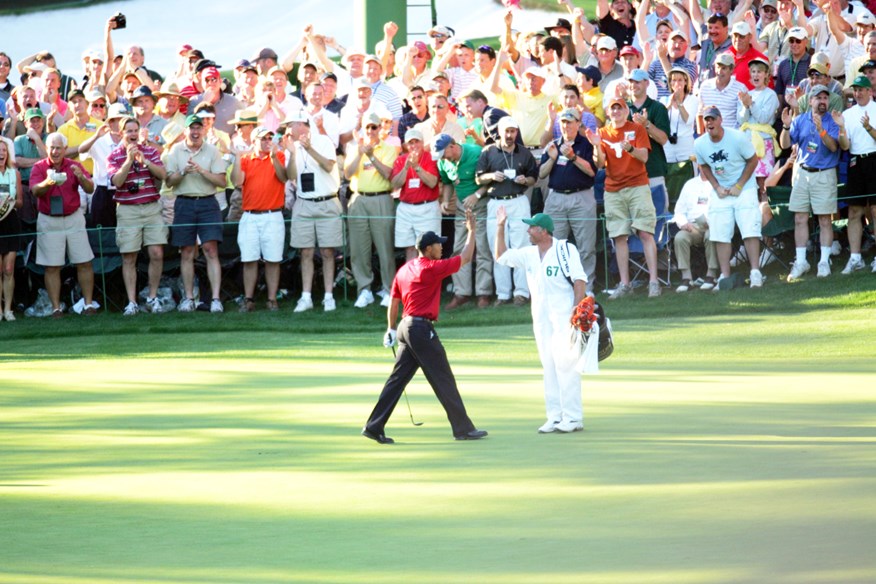The remarkable behind-the-scenes story of Tiger Woods’ iconic Masters chip
Last updated:
Can you believe it’s been 20 years since Tiger Woods’ chip dubbed the best shot ever hit at the Masters? But how you remember it could have been so different, as Alex Perry recalls…
We can all picture where we were when we witnessed the most famous shot to have ever been played on Augusta’s hallowed turf.
Tiger Woods, a single stroke clear of playing partner Chris DiMarco, had just pulled his 8-iron left of the par-3 16th on the final day of the 2005 Masters.
DiMarco had a 15-foot putt for birdie and, with the difficult chip facing Woods, there was a real possibility of a two-shot swing. “We were just trying to escape with a three,” Steve Williams, Woods’ caddie at the time, said afterwards.
An eerie silence encased Augusta. CBS commentator Verne Lundquist spoke gently into his microphone: “To get it close he’s going to have to put it up into the slope somewhat.
“It’s made a lot tougher by having that second cut right behind the ball. It almost forces him to have to play a low shot. He can’t put it up in the air with the second cut that close behind the ball.
“You can see him putting the ball right back in his stance here and hitting right down on it. He’s picked out a good landing spot which is some 25 feet away from the hole. There’s a good chance he doesn’t get this inside DiMarco’s ball.”
Lundquist paused as Woods addressed his ball. The world stood still.
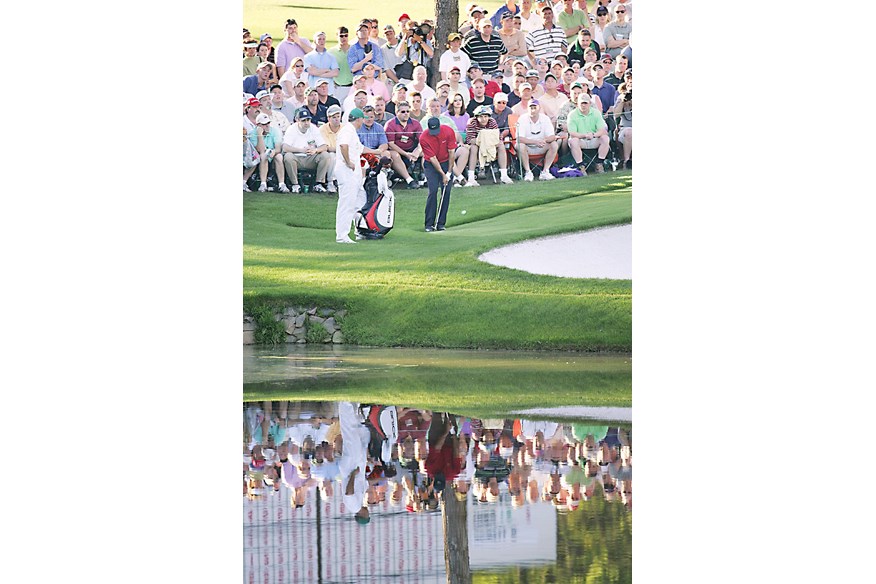
Woods pulled the trigger and his ball squirted across the green before it caught the top of the slope and gently trickled down to the hole.
“Oh my goodness,” Lundquist gasped.
The ball paused on the lip for what felt like an eternity before a gentle nudge from the golf gods – or “somehow an earthquake happened”, as Woods described it – tipped it into the cup.
“Oh, wow!” Lundquist bellowed. “In your life have you seen anything like that?”
An instantly iconic moment in golf history. The greatest player of all time. The impossible shot. The spine-tingling commentary.
How many times would you say you’ve watched that shot, either on YouTube or during television previews for each Masters? If you’re anything like me, you’re comfortably into three figures. Possibly four. Possibly eight.
In 2015 I was part of a production team at ESPN that interviewed Lundquist about that famous day in Georgia, and he recalled a fascinating tale about how the director helped shape the way we remember Woods’ chip to this day.
“I need to explain to people that don’t understand the seating in a production truck,” he explained. “At the very front, you’ve got the director, Steve Milton. He calls the shots, he decides what you see at home.
“So let’s just hypothetically say the number of the camera was 10. Well his role was to start wide on Tiger and follow it and come up – and it was always camera 10, camera 10, camera 10. He zoomed in as the ball began tumbling down the hill, and then as the ball slowed its descent toward the hole.”
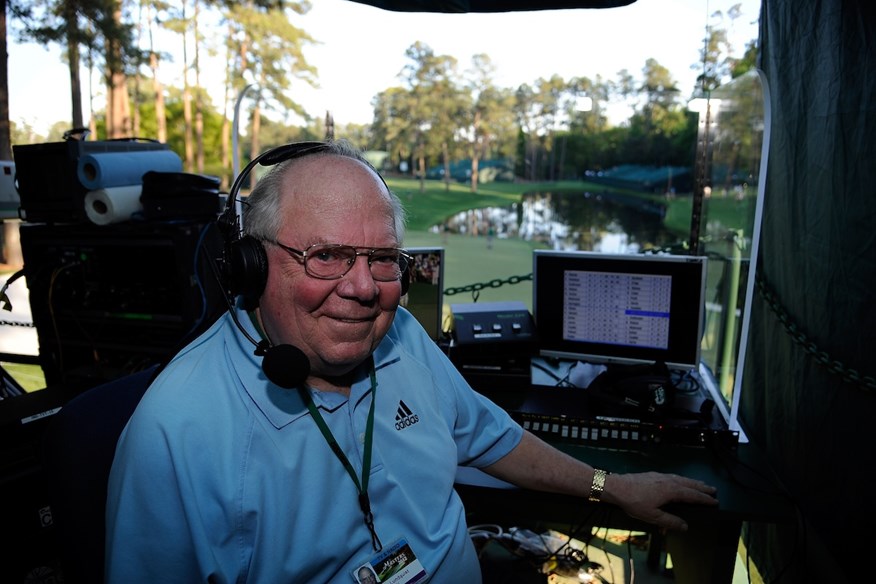
Motioning from his chest to the top of his head, Lundquist continued: “Steve had a flanker camera and his job was to shoot Tiger from here to here. Let’s say he was camera six.
“So as the ball seems to have come to a stop, Steve – as he properly should have – said: ‘Ready six … Take six!’ Norm Patterson, the technical director who actually punches the buttons that allow you to see whatever Steve has decided instinctively did not take six.
“And because he held on 10 and didn’t take six, we all saw what we saw. Norm just used his gut. And it changes everything about the shot. It changes what you remember at home. It changes what I said.
“Now here’s the poignant part. Norm was jogging in San Diego in January of 2006 and fell dead of a heart attack. He was in his early 40s. Steve went back and eulogized Norm and told that story at his funeral so that folks have an understanding of what he did and how he altered the way we all remember that shot.”
So next time you’re watching the chip heard around the world, just remember that you may not have seen it at all.
Thanks, Norm.
What happened after Tiger Woods’ chip?
DiMarco two-putted for par and Woods’ lead was two with two to play. But, with adrenalin still pumping, Woods drove into the trees at 17 and made a bogey. DiMarco’s safe par meant he was just one back on the 18th tee.
Both players missed the green, Woods was in a greenside bunker and DiMarco fell short. DiMarco played first and he almost had a famous chip of his own, only for his ball to ricochet off the pin.
Woods splashed out to set up a 15-foot par putt for the win, but it drifted away from the hole and consecutive bogeys meant DiMarco had 10 feet to force the playoff. He made no mistake.
Locked at 12-under, the pair returned to the 18th tee for the extra holes that no one could have possibly conceived but half an hour before.
Both players found the fairway but DiMarco again fell short of the green. This, remember, was at a time when courses were being ‘Tiger-proofed’ and Augusta had added around 300 yards to its length, as well as new bunkers and trees.
This time Woods found the putting surface and drained his 15-footer for a birdie and the win.
“For some reason, I hit two of the best golf shots I hit all week,” he said after, before describing his bogey-bogey finish in regulation play as “throwing up on myself”.
On the chip, Woods said he was “just trying to throw the ball up on the hill and and let it feed down to have a makeable putt”.
“I was just aiming at a spot, it was a spot in the trees that had a little light coming through, and I was just trying to hit the ball somewhere in that area,” he continued. “A lot of it was luck, and I hit the right spot.
“The biggest danger, I thought, was fatting it and getting too cute with it. All of a sudden it looked pretty good, then all of a sudden it looked really good. How could it not go in? How did it not go in? And all of a sudden it went in. It was pretty sweet.”

DiMarco added: “You expect the unexpected, and unfortunately it’s not unexpected when he’s doing it.”
DiMarco, who had also lost in extra holes in the previous major, the 2004 PGA Championship, was also a runner-up at the 2006 Open. The winner at Birkdale? You guessed it.
For Woods, that Masters win – his ninth major title – was one of the most poignant of his career as father, Earl, struggled with illness.
“It’s been a difficult year, he’s not doing very well,” he told the crowd at 18. “He made the trek to Augusta, but he was unable to come out and enjoy this.”
Fighting back tears, he added: “This is for dad. I can’t wait to get back to the house and give him a big bear hug.”
Earl died later that year and his son would go on to win another six majors, including a fifth Green Jacket in 2019 – this time with his own children watching on.
-
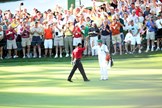 Tiger Woods' chip in 2005 is generally considered the best shot in Masters history.
Tiger Woods' chip in 2005 is generally considered the best shot in Masters history.
-
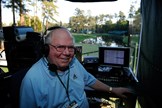 Verne Lundquist's commentary of Tiger Woods' Masters chip is as memorable as the shot itself.
Verne Lundquist's commentary of Tiger Woods' Masters chip is as memorable as the shot itself.
-
 Tiger Woods hits his chip shot that would give him a two-shot lead with two to play at the 2005 Masters.
Tiger Woods hits his chip shot that would give him a two-shot lead with two to play at the 2005 Masters.
-
 Tiger Woods' 2005 win was the fourth of his five Green Jackets.
Tiger Woods' 2005 win was the fourth of his five Green Jackets.
